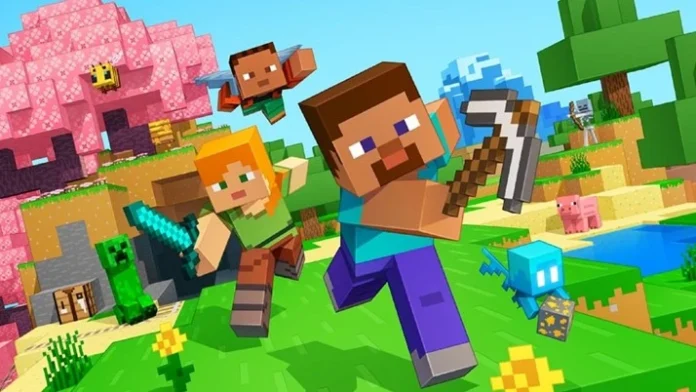[Reading level: B2 – Upper Intermediate]
Minecraft is an electronic game that allows players to build a fantasy world out of 3-D blocks. Swedish founder Markus Persson began developing the game in 2009 and officially released it in 2011. Minecraft is geared toward a wide audience. However, elementary school children through those in their mid-teens, particularly enjoy playing it. By 2016, Minecraft was the second-highest seller in video game history, behind Tetris. (Tetris allows players to rotate falling blocks strategically to clear levels.)
Persson first developed Minecraft as a computer game. Since then, however, it has been adapted for mobile devices, Xbox, and PlayStation. In Minecraft, players create their own game rather than follow the game plan of the developer. The game has few instructions or rules. To make up for the lack of guidance, players have set up online forums to discuss the game. Some have also made YouTube videos with tips on how to play. These actions have helped to spread the game’s popularity.
Minecraft is a creative game that focuses on building. Everything is made from blocks and looks cartoonlike. The blocks are made of various materials-such as stone, wood, dirt, or ore-that the players mine or collect after they detonate explosives. The players can play by themselves or join with others in building a communal world. They build a world from scratch, including buildings, clouds, and other parts of the natural environment. They can choose different modes in which to play, such as creative or survival.
In creative mode, the players have unlimited resources to use, can go where they want, and cannot be injured. In contrast, in survival mode, the players start with nothing. They need to collect resources and make tools. In addition, they can weaken or die from such misfortunes as starvation, accidents, or attacks. The players can also increase or decrease the level of difficulty based on their abilities.
Although Minecraft players create their own world, they may come into contact with game-generated roaming characters. These include villagers as well as farm animals such as pigs and cows. Unfriendly characters that players may encounter include zombies, skeletons, witches, and spiders. The players can fight and kill these monsters. However, all conflicts can be avoided by adjusting the settings on the game. The game does not contain graphic violence.
While Minecraft was on its way to becoming successful, Persson founded Mojang, a software company based in Stockholm, Sweden. In 2014, Microsoft acquired Mojang for $2.5 billion. Two years later, Microsoft obtained the educational branch of Minecraft. Minecraft: Education Edition is designed to enhance the school curriculum as a supplement to class lessons. It includes lesson plans for teachers in multiple subjects, including coding, history, geography, and math.
Examples of tasks include building an Egyptian pyramid, solving math puzzles, and devising a plan to colonize Mars. These activities are intended to encourage creativity, problem-solving skills, and teamwork. Multiple schools around the world-including in the United States, Australia, France, Germany, and the United Kingdom-have incorporated these lessons into the curriculum.
In 2010, Mojang began an annual Minecraft convention. In 2017, executives turned it into an interactive livestream event.
Source: https://kids.britannica.com/students/article/Minecraft/631450
WORD BANK:
release /rɪˈliːs/ [B2] (v): phát hành, công bố
be geared toward /ɡɪrd təˈwɔːrd/ [C1] (phr v): hướng đến, được thiết kế cho
strategically /strəˈtiː.dʒɪ.kli/ [C1] (adv): một cách chiến lược
spread one’s popularity /spred ˌpɑː.pjəˈlær.ə.t̬i/ [C1] (v phr): lan tỏa sự nổi tiếng của ai đó
cartoonlike /kɑːrˈtuːn.laɪk/ (adj): giống hoạt hình, mang phong cách phim hoạt hình
ore /ɔːr/ [C1] (n): quặng
detonate /ˈdet̬.ən.eɪt/ [C1] (v): kích nổ, cho nổ
explosive /ɪkˈsploʊ.sɪv/ [C2] (n): chất nổ, vật liệu nổ
misfortune /ˌmɪsˈfɔːr.tʃuːn/ [C1] (n): điều rủi ro, tai họa
starvation /stɑːrˈveɪ.ʃən/ [C1] (n): sự chết đói, đói khát nghiêm trọng
game-generated roaming characters /ˈɡeɪm ˌdʒen.ə.reɪ.tɪd ˈroʊ.mɪŋ ˈkær.ɪk.tɚz/ (n phr): các nhân vật lang thang do trò chơi tạo ra
supplement /ˈsʌp.lə.ment/ [B2] (n): sự bổ trợ, công cụ bổ trợ
colonize /ˈkɑː.lə.naɪz/ [C1] (v): chiếm làm thuộc địa, định cư ở
incorporate sth into sth /ɪnˈkɔːr.pɚ.reɪt/ [C1] (phr v): kết hợp, lồng ghép cái gì vào cái gì
executive /ɪɡˈzek.jə.tɪv/ [B2] (n): giám đốc điều hành, ban lãnh đạo
ỦNG HỘ READ TO LEAD!
Chào bạn! Có thể bạn chưa biết, Read to Lead là một trang giáo dục phi lợi nhuận với mục đích góp phần phát triển cộng đồng người học tiếng Anh tại Việt Nam. Chúng tôi không yêu cầu người đọc phải trả bất kỳ chi phí nào để sử dụng các sản phẩm của mình để mọi người đều có cơ hội học tập tốt hơn. Tuy nhiên, nếu bạn có thể, chúng tôi mong nhận được sự hỗ trợ tài chính từ bạn để duy trì hoạt động của trang và phát triển các sản phẩm mới.
Bạn có thể ủng hộ chúng tôi qua 1 trong 2 cách dưới đây.
– Cách 1: Chuyển tiền qua tài khoản Momo.
Số điện thoại 0947.886.865 (Chủ tài khoản: Nguyễn Tiến Trung)
Nội dung chuyển tiền: Ủng hộ Read to Lead
hoặc
– Cách 2: Chuyển tiền qua tài khoản ngân hàng.
Ngân hàng VIB chi nhánh Hải Phòng
Số tài khoản: 012704060048394 (Chủ tài khoản: Nguyễn Tiến Trung)
Nội dung chuyển tiền: Ủng hộ Read to Lead
Lớp luyện thi IELTS online
Bạn đang có nhu cầu thi chứng chỉ IELTS cho đầu vào đại học, đi du học, xin việc hay xin cư trú và đang phân vân chưa biết học ở đâu?
Nếu bạn đang tìm kiếm dịch vụ luyện thi IELTS online với giáo viên uy tín và chất lượng, cũng như học phí phải chăng, thì thầy Trung và Cô Thủy (Admin và dịch giả chính của Read to Lead) có thể là một lựa chọn phù hợp dành cho bạn.
Hãy liên hệ (nhắn tin) tới trang Facebook cá nhân của mình (https://www.facebook.com/nguyen.trung.509) để tìm hiểu về lớp học và được tư vấn cũng như được học thử nha!





